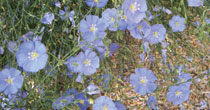How Gardening with Native Plants Improves the Health of Your Living Space and Promotes
Well-being
by Chet Neufeld

Gardening is known as a therapeutic pursuit for many people and can relieve stress. It also keeps the mind and body active. There are also many environmental benefits of green spaces around your home such as a more moderate temperature which decreases heating and cooling costs, increased biodiversity, habitat for beneficial wildlife, and better water capture.
Using native plants is a healthy and environmentally-friendly way to pursue your gardening interests, because they don’t require fertilizers or pesticides. Our native plants evolved without soil amendments and developed natural defences to the pests that feed on them. Native prairie plants also became adapted to growing in very hot and dry locations, so no watering is generally needed once the plants are established; they can survive merely from the rainfall.
Once established, your native plants will not only provide a peaceful haven for you, but they will provide food and habitat for many other creatures as well. I have found that my yard attracts far more birds than my neighbours’ yards, and my native flowers attract bees, butterflies, and other beneficial insects. With the decline of bee populations worldwide, it is more important than ever to help maintain them as they are responsible for pollinating much of the food we grow. Since landscaping my yard using native plants, I have had birds nesting in it every year (something that hasn’t happened even one time in my neighbours’ yards) and I have also had other creatures such as frogs and salamanders.
My wife and I purchased a house with an unlandscaped yard in Saskatoon in 2006 and started the landscaping process from scratch. As I often consult with people about using native plants in landscaping through my position with the Native Plant Society of Saskatchewan, I thought it would be a great opportunity to practice what I had been preaching and use my own yard as a demonstration site. Like all landscaping projects that start from scratch, we started with the main feature which, in our case, was creating a dry creek bed in our front yard. We achieved a creek that flows without needing a garden hose by having the downspouts drain into the creek along its length. When it’s hot and sunny, we have a dry creek bed. When it rains, our creek flows and creates a pond at the end which sometimes stays for days. We planted dogwoods (Cornus spp.) in the pond portion, as they are attractive throughout the year and don’t mind having wet feet.
Once topsoil was laid down, the first things we planted were the trees and shrubs, as these are focal points which anchor the look of your yard. Since they take a long time to mature, planting them earlier than everything else helps them get a head start. Using trees and shrubs in your design is a shrewd move, as once they are established they require little to no extra water and provide shade which moderates temperature and slows evaporation. We not only wanted the trees and shrubs to look good, but to serve a more functional purpose by feeding us. Therefore, we planted raspberries (Rubus spp.), currants (Ribes spp.), saskatoons (Amelanchier alnifolia), and blueberries (Vaccinium spp.), among others.
To fill in the spaces and to add a splash of colour to the raised beds, we chose a variety of native wildflowers. While a wildflower meadow has a beautiful random smattering of different colours and species, we chose to group multiple plants of the same kind together to draw attention to each grouping and make it look more orderly. We also arranged the groups with the smallest plants at the front and gradually introduced taller plants toward the back of the raised beds. For yellow and orange groupings, we chose species such as western red lily (Lilium philadelphicum var. andinum), yellow monkey flower (Mimulus guttatus), scarlet mallow (Sphaeralcea coccinea), gaillardia (Gaillardia aristata), black-eyed susan (Rudbeckia hirta), late yellow locoweed (Oxytropis monticola), and prairie coneflower (Ratibida columnifera). For blue and purple groupings, we chose species like wild blue flax (Linum lewisii), dotted blazingstar (Liatris punctata), purple prairie clover (Dalea purpurea), prairie crocus (Pulsatilla patens), blue-eyed grass (Sisyrinchium montanum), wild bergamot (Monarda fistulosa), and smooth blue beardtongue (Penstemon nitidus).
After the creek and raised beds were taken care of, I still had plenty of space left, which I filled with lawn. We used a mix of two native grasses, blue grama (Bouteloua gracilis) and June grass (Koeleria macrantha). We chose these two species because they are both extremely drought tolerant, grow very short (about 8-12 inches) and have attractive little seed heads. The nice thing about these native grasses is that when you stop watering them, they stop growing upward and direct their energy into growing deeper roots to look for water. This means that mowing is reduced to a few times a summer, which reduces greenhouse gas contributions, and watering is essentially eliminated.
Native prairie plants are a great choice for landscaping and those who use them will be rewarded with a beautiful yard. Using native plants is not an all-or-nothing decision; you can start with just one plant and if you like it, you can expand over time. If you are searching for sources of native plants and seeds, or seek more advice, please feel free to contact me.
Chet Neufeld is a plant ecologist and Executive Director of the Native Plant Society of Saskatchewan (NPSS). For NPSS membership inquiries visit the website at www.npss.sk.ca. You can also email info@npss.sk.ca or call the office at (306) 668-3940
in Saskatoon.
|
